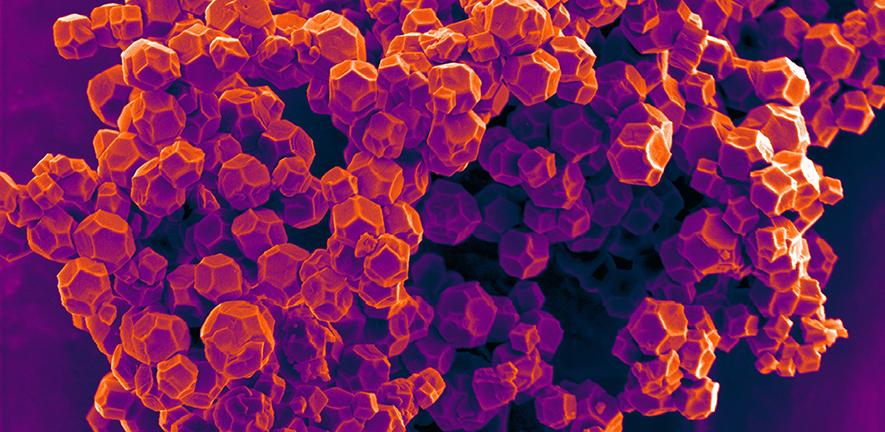A large international study led by the Centre for Membrane Separations, Adsorption, Catalysis, and Spectroscopy for Sustainable Solutions (cMACS) at KU Leuven (Dr. Julian A. Steele, Prof. Maarten B. J. Roeffaers, and Prof. Johan Hofkens) and with major contributions from the Center for Molecular Modeling (CMM) at Ghent University (Tom Braeckevelt, Dr. Kurt Lejaeghere, Dr. Sven M. J. Rogge, and Prof. Veronique Van Speybroeck) for the first time explains how a promising type of perovskites – man-made crystals that can convert sunlight into electricity – can be stabilized. As a result, the crystals turn black in appearance, enabling them to absorb sunlight. This is necessary to be able to use them in new solar panels that are easy to make and highly efficient. The collaborative study, spanning 11 research groups spread out over 8 institutes and 6 countries, was published in Science. The work was supported, among others, by 7 FWO postdoctoral fellowships, 1 FWO-SB fellowship, and 2 ERC grants, and was featured in articles by De Standaard and VRT NWS (both in Dutch).
Perovskites as promising solar cell materials
Perovskites are semiconductor materials that have many applications. They show particular promise in harvesting solar energy. Currently, most solar cells are made with silicon crystals, a relatively straightforward and effective material to process for this purpose. Perovskite-based devices offer the possibility for higher conversion efficiencies than silicon, but some of the most promising perovskites, namely cesium lead triiodide (CsPbI3), are very unstable at room temperature. Under these conditions, they have a yellow color, as the crystal does not form a perovskite structure (the way that atoms arrange themselves in the crystal). For the crystals to absorb sunlight efficiently and turn it into electricity, they should be in a black perovskite phase – and stay that way.
“Silicon forms a very strong, rigid crystal. If you press on it, it won’t change its shape. On the other hand, perovskites are much softer and more malleable,” explains Dr. Julian Steele of cMACS. “We can stabilize them under various lab conditions, but at room temperature, the black perovskite atoms really want to reshuffle, change structure, and ultimately turn the crystal yellow.”
Make perovskites stable again by thin film deposition
The international team of scientists discovered that by binding a thin film of perovskite solar cells to a sheet of glass, the cells can obtain and maintain their desired black form. The thin film is heated to a temperature of 330 degrees Celsius, causing the perovskites to expand and adhere to the glass. After heating, the film is rapidly cooled down to room temperature. This process fixates the atoms in the crystals, restricting their movement, so that they stay in the desired black form.
“There are three pillars that determine the quality of solar cells: price, stability, and performance. Perovskites score high on performance and price, but their stability is still a major issue,” says Steele. Scientists had already been observing for several decades that perovskites can retain their blackness after heating, but it was as of yet unclear why. “In our study, we chose CsPbI3 because its performance is very high,” Steel explains. “Additionally, it is one of the most unstable types of perovskites, which means it is sensitive to the method we describe, and should translate to other unstable perovskites.”
Unraveling the fundamental mechanism leading to stabilization
To understand the molecular mechanism underpinning these experimental observations, researchers at the CMM computationally investigated how this experimental procedure may stabilize the black and yellow phases of the perovskite. To this end, they mimicked the interfacial strain at the perovskite/glass substrate, and computationally determined how this strain affects the stability of both the black and the yellow phases. These computational results were vital to rationalize why the black phase is stabilized with respect to the yellow phase when fixating the perovskite as a thin film to a glass substrate.
How the bonding takes place exactly, is still a mystery, though there are hypotheses. “Normally, we would take a microscope with atomic resolution and directly have a look. However, that’s impossible with perovskites, as they don’t like to be looked at with such high-resolution imaging instrument.”
“Understanding how this mechanism works will help further research to ultimately develop solar panels that use pure perovskite crystals,” Steele says. “Since the entry level for processing perovskite-based solar cells is relatively low, they can be very beneficial for people in developing countries.” Additionally, perovskites can be used in LEDs, optical detectors, transistors, x-ray detectors and more.
Technical info
These results were published in Science:
Thermal unequilibrium of strained black CsPbI3 thin films
Julian A. Steele, Handong Jin, Iurii Dovgaliuk, Robert F. Berger, Tom Braeckevelt, Haifeng Yuan, Cristina Martin, Eduardo Solano, Kurt Lejaeghere, Sven M. J. Rogge, Charlotte Notebaert, Wouter Vandezande, Kris P. F. Janssen, Bart Goderis, Elke Debroye, Ya-Kun Wang, Yitong Dong, Dongxin Ma, Makhsud Saidaminov, Hairen Tan, Zhenghong Lu, Vadim Dyadkin, Dmitry Chernyshov, Veronique Van Speybroeck, Edward H. Sargent, Johan Hofkens, and Maarten B. J. Roeffaers
Science, dx.doi.org/10.1126/science.aax3878
ir. Tom Braeckevelt, dr. ir. Kurt Lejaeghere, dr. ir. Sven M. J. Rogge, prof. dr. ir. Veronique Van Speybroeck
Center for Molecular Modeling
Technologiepark 46, 9052 Zwijnaarde
M +32 (0)478 82 34 19







